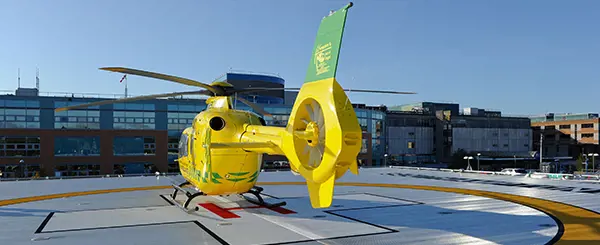
Helicopter operations and the need to balance competing interests
Tabitha Knowles
30 Jun 2017
In land use planning, helicopter operations are often seen as a contentious NIMBY issue with multiple competing and conflicting views. There is a need to balance the benefits that helicopter operations can bring against any negative impact.
Helicopter operations have a key role to play in the delivery of sustainable development at a local and national level – providing jobs, movement of people and goods, and inward investment. They also provide a range of functions, including the transportation of people and equipment, military operations, emergency services such as the Coastguard, Police, air ambulance, aid drops and medi-vacs - and the all-important news gathering. They save time and lives by providing point to point access to locations where other forms of transport can’t reach. In an era of increasing security concerns, helicopters are able to move individuals perceived to be at risk, safely and quickly, particularly in urban areas. Helicopter airport infrastructure (airports, helipad and heliports) are hubs for this aviation activity. Within the context of land use planning, it’s important that there is adequate protection of helicopter infrastructure so helicopters are able to carry out and sustain their operations (safely and efficiently) to deliver these benefits.
Negative perceptions surrounding helicopter operations are that they have limited passenger-carrying capacity, limited range and fly time, are a very expensive mode of transport often seen as exclusively for the rich and few, and can result in considerable environmental impact, particularly in built-up urban areas. Within the context of land use planning, proposals for helipads and heliports can be met with resistance, given the perceived low economic benefit and high environmental impact. The exceptions in people’s minds are facilities for emergency helicopter operations, which have a recognised social purpose that offsets the environmental impacts.
To balance the actual and perceived benefits of helicopter operations and the actual and perceived negative impact of helicopters – as well as the need to ensure safe and efficient operations – the provision of helicopter infrastructure is carefully regulated by both the Civil Aviation Authority (CAA) (as the regulator), and planning law and policy. The result is a complex regulatory and policy system, which raises some interesting questions:
- In the UK there are numerous locations being used as helicopter landing sites throughout the year. Others involve seasonal peak activities, particularly during the summer period. At what point do such sites, used on an ad-hoc and informal basis, trigger the need to obtain planning permission and aerodrome approvals from the CAA? Ultimately it will depend on the volume and timing of operations and each case needs to be considered on its merits.
- Is the socio-economic contribution of helicopter operations properly recognised in national, regional and local planning – or do the potential environmental impacts instantly override this benefit? The London planning system is a good example. Additional helicopter infrastructure is in demand for what is a world city, yet any proposals for new heliports are resisted as a matter of policy by the Mayor of London, with the exception of emergency services provision. The London Plan states that the noise impacts from helicopters can be considerable in an urban environment and that there are few locations in the capital where a heliport could be located without having major impacts on residents. Perhaps it is time to make more explicit just what the socio- economic benefits of helicopter operations are, to counterbalance the strong weight given to avoiding perceived environmental impacts.
- Is the overarching requirement for safe operations – as laid out in CAA regulations - compatible or at odds with the objectives of land use planning? Can the site be used safely and in accordance with the applicable safety rules? Are there neighbouring congested areas? Does the airspace need to be shared with other aeronautical interests? It’s vital that any existing or proposed development nearby, which could give rise to the creation of obstacles and hazards and impact on a site’s ability to carry out its operations, is carefully monitored and regulated. But how well is this requirement to safeguard being applied in the land use planning process? Are there appropriate and known procedures in place, and are they being implemented?
If the current position on heliport land use planning policy and some recent planning decisions are anything to go by, it would seem that there is still much uncertainty around these questions - that is, how and why there is a need to balance the competing and conflicting views of helicopter operations.
*Lichfields is a member of the British Helicopter Association (BHA).

